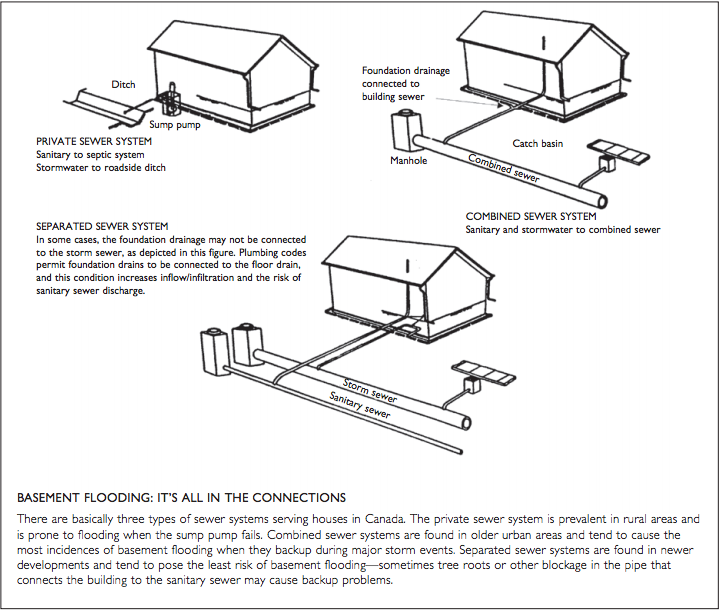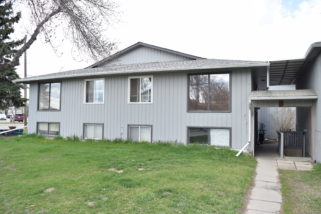Avoid Basement Flooding
Avoid Basement Flooding
Is Basement Flooding a Common Problem?
Basement flooding is unfortunately a common occurrence in many parts of Canada. Basement flooding related insurance claims in Canada are estimated to be in the order of $140 million per year based on a multi-year average. This represents an average of approximately 30,000 to 40,000 incidents per year, with an average cost of damages per flooding incident between $3,000 and $5,000. Many cases of basement flooding are not reported. But the good news is that many types of basement flooding may be avoided. This publication explains some of the practical steps you can take to avoid basement flooding.
How Serious Is Basement Flooding?
Basement flooding is now being recognized as a potentially serious problem. There are many negative consequences associated with basement flooding, above and beyond the inconvenient mess and disruption of household routine. Recent research cites the following impacts:
- Chronically wet houses are linked to an increase in respiratory problems.
- Frequent occurrences of basement flooding can result in long-term damage to the building and equipment that may not be covered by insurance.
- Insurance rates may rise to compensate for repeated basement flooding claims, and/or the minimum deductible may be increased significantly.
- Property value may depreciate because the basement is prone to frequent flooding.
Before appropriate measures can be taken, it is important to identify the causes of basement flooding. These range from problems originating in the individual dwelling to problems associated with the municipal sewer systems that serve entire communities.
Why Do Basements Flood?
Water can enter your basement for a number of reasons. Water in your basement is most likely to occur during periods of heavy rainfall, or when snow is melting rapidly during a spring thaw. In these cases, your basement can be wet because of:
- a leak or crack in your home’s basement walls
- poor lot drainage
- failure of the weeping tiles (foundation drains)
- overflowing eavestroughs or leaking/plugged downspouts
Basement flooding may also occur because of:
- a blocked connection between your home and the main sewer in the street
- a back-up of wastewater in the sewer system (or a combination of wastewater and rainwater from the sanitary or combined sewer system)
- failure of a sump pump (in some areas) used to pump weeping tile water
Basements are also vulnerable to natural river flooding disasters, but these cannot be addressed by individual homeowners.
Flooding Basics
Municipalities attempt to prevent flooding by maintaining the public sewer system. Homeowners with private sewage systems (septic tank and field bed) can appreciate the need for regular maintenance, but unforeseen or accidental problems can occur in any type of system. This is some municipal infrastructure terminology you should know (Figure 1).
Figure 1
Sanitary Sewer
A sanitary sewer is a pipe buried beneath the street that is designed to transport wastewater from your home. This consists of water from sanitary fixtures and floor drains inside your house, and in some areas includes groundwater from weeping tiles around the foundation of your home.
Storm Sewer
A storm sewer is a pipe buried beneath the street that is designed to carry storm-related water runoff. Storm sewers are normally much larger than sanitary sewers because they are designed to carry much larger amounts of flow.
Sewer Backup
Extra storm-related water (from sources other than wastewater and groundwater) should flow into the storm sewer or soak slowly into the ground without entering the sanitary sewer. If excess storm water does enter the sanitary sewer system, it can overload this kind of system.
When the sewers are overloaded, the water level in the system rises above normal design levels, and this condition is referred to as surcharge. Basement flooding can occur if the home has sanitary fixtures or floor drains below the surcharge level (Figure 2).
Figure 2
Practical Measures to Avoid Basement Flooding
Basement flooding problems are best diagnosed by working your way down from the eavestroughs and downspouts, to the lot and foundation drainage, and then to the plumbing system — both inside your home and beyond its connection to the municipal sewer system.
Eavestroughs and Downspouts
Water pours off your eavestroughs into downspouts. If the downspouts are dumping the water right beside your foundation, it drains directly to the weeping tile and can easily overload your home’s drainage. Make sure downspouts extend at least 1.8 metres (6 feet) from your basement wall. Also, be sure the water does not drain toward your neighbour’s basement walls. It should drain away from your house toward the street, rear yard, or back lane.
If your downspouts are connected to your home’s sewer system, or weeping tile, disconnect them.
Clean debris from eavestroughs regularly. If they overflow even when clean, replace them with larger size eavestroughs and downspouts.
Lot Grading
If the land around your home slopes in toward the foundation, rainwater heads right for the weeping tile around the basement and can overload your foundation drainage system. The land around many homes settles over time, and then slopes in toward the foundation. If your lot slopes inward, you’ll want to fill in and grade the lot so that, for at least 1.8 metres (6 feet) out from around the foundation, the land slopes away from your house.
Build up the ground around your house so that water drains away from your basement walls. Also, examine sidewalks, patios, decks and driveways. These can settle over time and cause water to drain back towards your basement walls (Figure 3).
Extend downspouts so that water flows away from your house and does not collect next to the basement walls and windows.
Proper drainage helps to:
- Reduce the amount of water flowing to your home’s sewer system and to the main sewer system, and lessen the risk of sewer backup
- Reduce water seepage into your home through basement windows and cracks in your basement walls.
- Keep the moisture content of the soil around and under your house stable to reduce the chances of cracking and shifting. If water collects next to your basement, it can make its way to the footings that support the basement walls. The increased moisture may cause the footings to heave or settle
- Extend the life of your sump pump by reducing the amount of work it has to do.
Be sure that any drainage improvements you make do not cause water to flow onto your neighbour’s property.
Figure 3
Floodproofing Devices
If your home drainage system or the neighbourhood’s drainage system overloads, you may still be able to prevent rain water and sewage from backing up into your basement by installing one or more floodproofing devices, such as sump pumps or back flow valves. Each installation is unique and some devices (back flow valves) may require a plumbing permit. Check with your municipal office or a qualified plumber before you proceed with any installation.
Sump Pit Drainage System
A sump pit drainage system includes a sump pit, a sump pump and a discharge pipe. The sump pit, set into the basement floor, collects water from the weeping tiles around your basement. The pump pushes the water outside your house through the discharge pipe (Figure 4).
Place your sump pump discharge pipe so that it:
- drains somewhere onto your property where water can be absorbed, such as your lawn or flower bed
- does not direct water onto neighbouring properties, lanes, sidewalks, or streets.
Figure 4
Sump Pit
Clean the pit each year after freeze-up. Weeping tile drainage may carry small amounts of soil, sand and debris into the pit from around your basement foundation.
- Some water may remain in the pit and cause a musty smell if it sits for a long time. If so, you can flush the pit by adding fresh water until the pump removes the stale water.
Sump Pump
- Check and test your pump each spring before the rainy season begins, and before you leave your house for a long time. Pour water into the pit to trigger the pump to operate.
- Remove and thoroughly clean the pump at least once a year. Disconnect the pump from the power source before you handle or clean it.
- Check the pit every so often to ensure it is free of debris. Most pumps have a screen that covers the water intake. You must keep this screen clean.
Sump Pump Discharge Pipe
- Check the place where the discharge pipe leaves the house. If the pipe is discharging right against the basement wall, the water will drain down into the weeping tiles and continue to recycle through the system.
- Check the discharge point regularly to make sure that nothing is blocking the flow.
- If your pump runs frequently in the winter, and the resulting ice is causing hazardous conditions on the lawn and sidewalks, call your municipal office.
Backwater Valve
A backwater valve is a device that prevents sewage in an overloaded main sewer line from backing up into your basement. The valve automatically closes if sewage backs up from the main sewer (Figure 5). A properly installed backwater valve must be placed so that sewage backup will be stopped and not come out through other outlets in your basement, such as sinks, toilets, showers and laundry tubs.
- Make sure that you can get at the valve at all times.
- Check the valve regularly and remove any material that may prevent the valve from operating properly.
You will normally require a permit and inspection to install a backwater valve and sump pit. Since part of the basement floor will be dug up and since proper placement of these items is important, we recommend that you use a qualified plumbing contractor.
Figure 5
Plumbing Fixture Maintenance
Have a qualified plumber inspect all floodproofing devices and plumbing fixtures (i.e. sump pumps, backwater valves, floor drains, etc.) regularly to ensure proper operation. Check the operating instructions for more detailed information and safety guidelines, or ask your plumber to explain the details of your system to you.
Additional Protection Measures
There are also several additional flood protection measures that may be considered.
Backup Sump Pump
Severe storms are often accompanied by power blackouts. A battery powered backup sump pump may be a prudent investment. Most pumps are made to fit in beside the main sump pump and also have an audible alarm that warns the main pump has failed so that you can attend to its repair or replacement. There are also water powered backup sump pumps available that run by water flowing through the pump impeller.
Basement Finishes and Furnishings
In the event a risk of basement flooding is still possible, it is advisable to install impermeable floor and wall finishes, such as ceramic tile, to lessen damage and make cleanup easier. Make sure basement furniture has legs that keep the furniture fabrics above any accumulated flood water. Area rugs are a good alternative to full broadloom as these can be removed and properly cleaned in the event of flood damage.
Insurance — Just In Case
Insurance that fully covers basement flooding damage is an important means of financial protection to homeowners.
Most policies include or can include coverage for damage caused by sewer back-up. Make sure your policy includes sewer back-up insurance.
Check regularly with your insurance agent or broker to ensure you have appropriate and adequate insurance coverage, including any extensions in coverage that may be available, which were not previously attached.
Keep a detailed inventory of your residence. It will be invaluable in the event of loss.
Make sure your insurance policies and related records are in a safe location and easily available after an emergency or disaster event.
Sources of Information
Additional sources of information related to basement flooding are listed below. Always check with your local municipality or plumbing inspection department for the latest information on basement flood protection.
Associations
Sump and Sewage Pump Manufacturers Association
http://www.sspma.org/
Acknowledgements
CMHC wishes to acknowledge the contributions of numerous Canadian municipalities to this publication. All of their public information bulletins were consulted during the development of this publication. Their assistance and cooperation are greatly appreciated.
View the CHMC Web site at http://www.cmhc-schl.gc.ca/en/co/maho/gemare/gemare_002.cfm



































